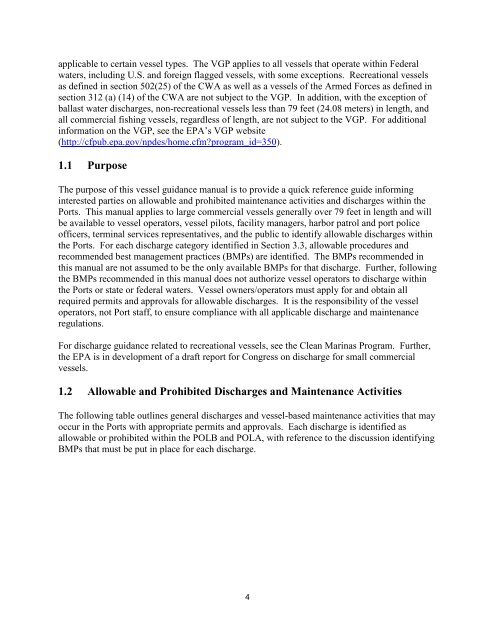Vessel Discharge Rules and Regulations - The Port of Los Angeles
Vessel Discharge Rules and Regulations - The Port of Los Angeles
Vessel Discharge Rules and Regulations - The Port of Los Angeles
Create successful ePaper yourself
Turn your PDF publications into a flip-book with our unique Google optimized e-Paper software.
applicable to certain vessel types. <strong>The</strong> VGP applies to all vessels that operate within Federal<br />
waters, including U.S. <strong>and</strong> foreign flagged vessels, with some exceptions. Recreational vessels<br />
as defined in section 502(25) <strong>of</strong> the CWA as well as a vessels <strong>of</strong> the Armed Forces as defined in<br />
section 312 (a) (14) <strong>of</strong> the CWA are not subject to the VGP. In addition, with the exception <strong>of</strong><br />
ballast water discharges, non-recreational vessels less than 79 feet (24.08 meters) in length, <strong>and</strong><br />
all commercial fishing vessels, regardless <strong>of</strong> length, are not subject to the VGP. For additional<br />
information on the VGP, see the EPA’s VGP website<br />
(http://cfpub.epa.gov/npdes/home.cfm?program_id=350).<br />
1.1 Purpose<br />
<strong>The</strong> purpose <strong>of</strong> this vessel guidance manual is to provide a quick reference guide informing<br />
interested parties on allowable <strong>and</strong> prohibited maintenance activities <strong>and</strong> discharges within the<br />
<strong>Port</strong>s. This manual applies to large commercial vessels generally over 79 feet in length <strong>and</strong> will<br />
be available to vessel operators, vessel pilots, facility managers, harbor patrol <strong>and</strong> port police<br />
<strong>of</strong>ficers, terminal services representatives, <strong>and</strong> the public to identify allowable discharges within<br />
the <strong>Port</strong>s. For each discharge category identified in Section 3.3, allowable procedures <strong>and</strong><br />
recommended best management practices (BMPs) are identified. <strong>The</strong> BMPs recommended in<br />
this manual are not assumed to be the only available BMPs for that discharge. Further, following<br />
the BMPs recommended in this manual does not authorize vessel operators to discharge within<br />
the <strong>Port</strong>s or state or federal waters. <strong>Vessel</strong> owners/operators must apply for <strong>and</strong> obtain all<br />
required permits <strong>and</strong> approvals for allowable discharges. It is the responsibility <strong>of</strong> the vessel<br />
operators, not <strong>Port</strong> staff, to ensure compliance with all applicable discharge <strong>and</strong> maintenance<br />
regulations.<br />
For discharge guidance related to recreational vessels, see the Clean Marinas Program. Further,<br />
the EPA is in development <strong>of</strong> a draft report for Congress on discharge for small commercial<br />
vessels.<br />
1.2 Allowable <strong>and</strong> Prohibited <strong>Discharge</strong>s <strong>and</strong> Maintenance Activities<br />
<strong>The</strong> following table outlines general discharges <strong>and</strong> vessel-based maintenance activities that may<br />
occur in the <strong>Port</strong>s with appropriate permits <strong>and</strong> approvals. Each discharge is identified as<br />
allowable or prohibited within the POLB <strong>and</strong> POLA, with reference to the discussion identifying<br />
BMPs that must be put in place for each discharge.<br />
4

















